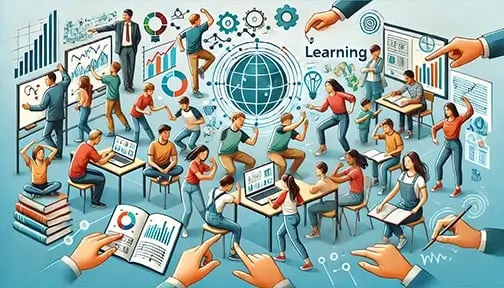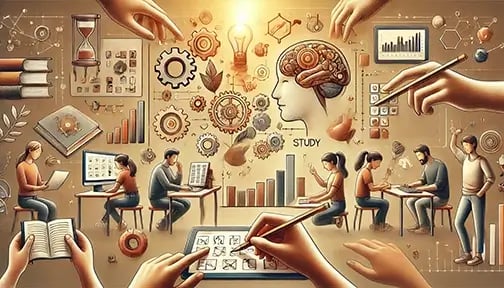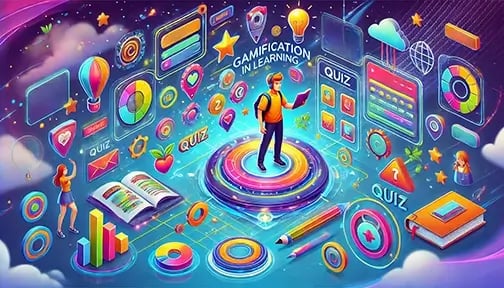Learning is most effective when it actively engages the brain and body. While traditional studying methods rely on reading and listening, incorporating movement and gestures can significantly reinforce learning by making information more memorable and engaging. Whether you're a student, educator, or lifelong learner, adding physical activity to your learning process can improve retention, focus, and understanding.
In this blog post, we'll explore why movement enhances memory, how gestures support comprehension, and practical ways to integrate kinesthetic learning strategies into everyday education.
Why Movement Can Reinforce Learning
Research shows that movement activates multiple areas of the brain, helping learners process and retain information more effectively. When we engage in physical activity while learning, we create additional neural connections, making it easier to recall information later.
Key Benefits of Using Movement in Learning:
Improves Memory Retention – Physical engagement strengthens neural pathways, making recall easier.
Enhances Focus and Engagement – Movement prevents mental fatigue and increases attentiveness.
Supports Different Learning Styles – Kinesthetic learners, in particular, benefit from hands-on interaction.
Reduces Stress and Anxiety – Physical activity can help lower stress levels, making learning more enjoyable.
Boosts Creativity and Problem-Solving – Movement stimulates brain function, leading to improved critical thinking skills.
Incorporating movement into learning doesn’t require intense exercise—small, deliberate gestures can make a big impact.
How Gestures Help Reinforce Learning
Gestures, or physical movements associated with speech, play an essential role in communication and learning. From pointing to emphasizing key ideas with hand movements, gestures provide visual cues that help learners process and remember information more effectively.
Why Gestures Matter in Learning:
Enhance Understanding – Using gestures while explaining concepts helps learners visualize ideas.
Create Stronger Memory Connections – Associating gestures with information provides additional memory cues.
Support Language Learning – Pairing words with physical movements helps reinforce vocabulary and grammar.
Encourage Active Participation – Engaging in gestures keeps learners physically involved and focused.
Practical Ways to Use Movement & Gestures to Reinforce Learning
Now that we understand the importance of movement and gestures, let’s explore practical ways to apply them in different learning environments.
1. Act Out Concepts with Physical Movements
Certain subjects, such as science, history, and language learning, lend themselves well to physical demonstrations.
In science, mimic the motion of planets orbiting the sun or demonstrate how molecules interact.
In history, reenact key historical events to bring lessons to life.
In language learning, pair words with corresponding movements, such as mimicking eating when learning food vocabulary.
2. Use Hand Gestures to Emphasize Key Ideas
Even simple hand gestures can make information more memorable.
When discussing math problems, use finger gestures to represent numbers or operations.
Point to different parts of a diagram while explaining complex ideas.
Use exaggerated gestures to highlight key terms or definitions in a lecture.
3. Incorporate Movement into Study Sessions
Learning doesn’t have to happen while sitting still. Try these movement-based strategies:
Walk While Reviewing Notes – Reading aloud while pacing engages multiple senses.
Use Flashcards with Motion – Hold up a flashcard, say the answer, then move it to another location as you progress.
Exercise and Learn – Stretch or do light physical activity while listening to an audiobook or recorded lecture.
4. Engage in Role-Playing and Simulation Exercises
For subjects that require practical application, role-playing can help reinforce learning.
Have students act out real-life scenarios in business, law, or healthcare education.
Use simulation-based learning for subjects like CPR training, public speaking, or conflict resolution.
Encourage group discussions where participants must use gestures to explain concepts.
5. Create Dance or Rhythm-Based Learning Techniques
Movement tied to rhythm can improve retention, especially for memorization-heavy subjects.
Use clapping patterns or foot taps to memorize multiplication tables.
Create movement sequences to remember historical dates or scientific formulas.
Incorporate dance routines to reinforce storytelling or literature themes.
6. Try the Memory Palace Technique with Movement
The Memory Palace technique, which involves associating information with specific physical locations, can be enhanced by movement.
Assign each fact or concept to a particular place in a room.
Walk through the space while mentally retrieving information.
Use hand movements to guide visualization exercises.
7. Use Interactive Whiteboards and Physical Learning Aids
Using interactive tools encourages physical engagement.
Write and erase concepts repeatedly on a whiteboard to reinforce memory.
Arrange sticky notes or flashcards in different orders to quiz yourself.
Engage in hands-on activities like building models or assembling puzzles related to learning content.
Integrating Movement-Based Learning in Different Settings
Movement and gestures can be applied across different learning environments, including classrooms, workplaces, and at-home study sessions.
In the Classroom
Teachers can integrate movement by:
Encouraging students to stand and present material using gestures.
Organizing group activities that require movement, such as scavenger hunts for vocabulary words.
Implementing call-and-response gestures to reinforce important concepts.
In Online Learning
Even in virtual environments, movement can be incorporated:
Encourage students to physically respond to questions using thumbs-up or clapping motions.
Assign video projects where learners act out concepts.
Suggest stretching or movement breaks between lessons to maintain focus.
For Self-Directed Learners
If you’re studying on your own, try:
Walking through different rooms while recalling information.
Using physical props like a pen or ball to reinforce study material.
Practicing sign language or gestures for key learning points.
Overcoming Challenges with Movement-Based Learning
Despite the benefits, some learners or educators may feel hesitant about incorporating movement into learning due to limited space, time constraints, or concerns about distractions. Here are some solutions:
Space Limitations – Small hand gestures or subtle movement techniques can be just as effective.
Time Constraints – Short, structured movement breaks can be incorporated without taking too much time.
Minimizing Distractions – Set clear guidelines for when movement is appropriate, such as during review sessions.
Final Thoughts: Move to Learn, Learn to Move
Adding movement and gestures to the learning process helps reinforce learning by engaging both the body and mind. Whether through physical reenactments, simple hand gestures, or interactive study techniques, movement-based learning enhances retention, comprehension, and engagement for learners of all ages.
By making learning more dynamic, we tap into the natural ways our brains are wired to absorb and recall information. Start incorporating movement and gestures into your study routine today and experience the benefits firsthand!




